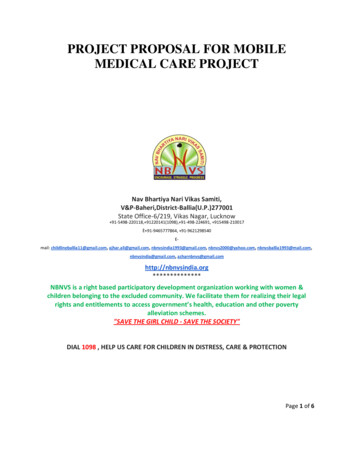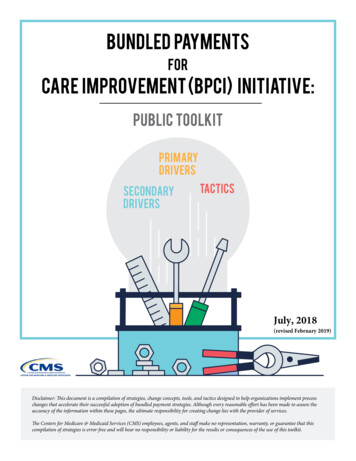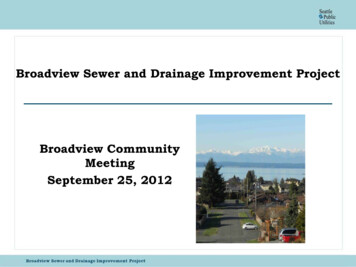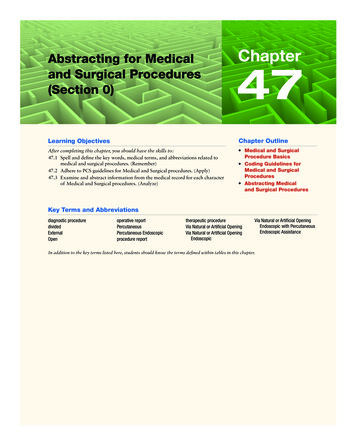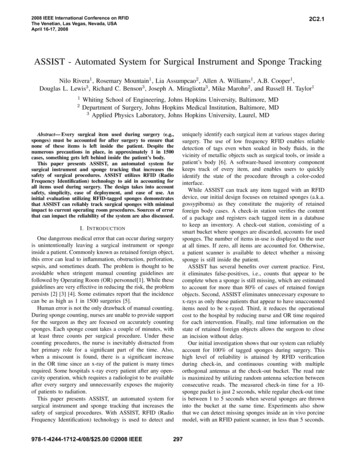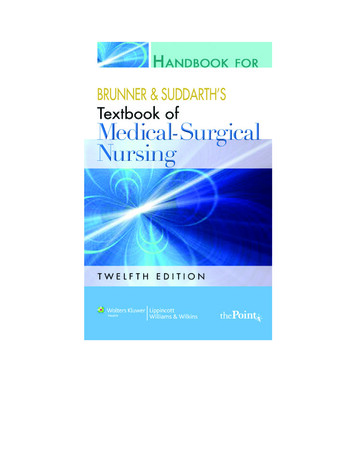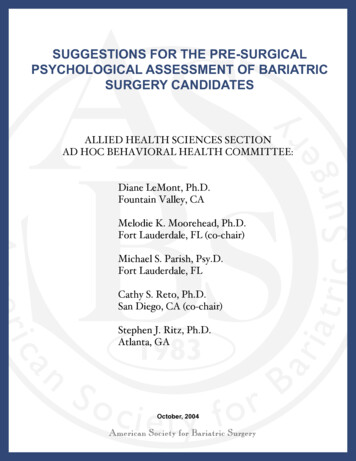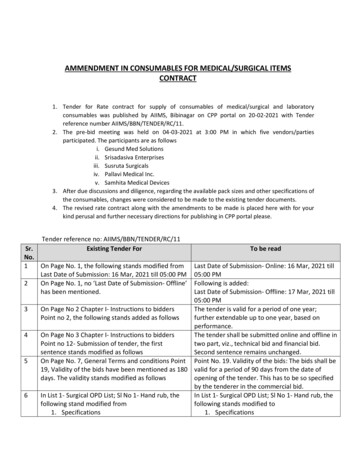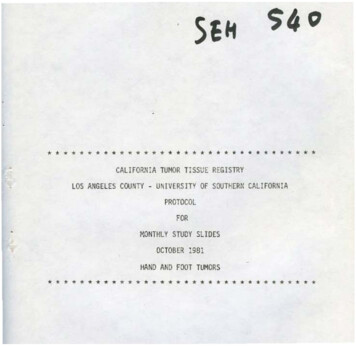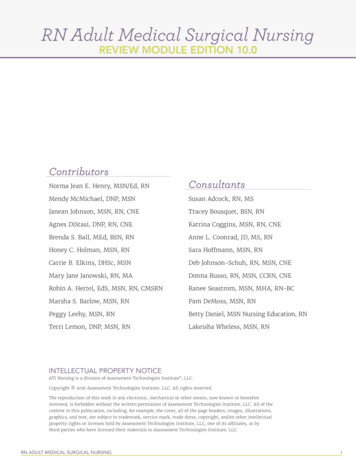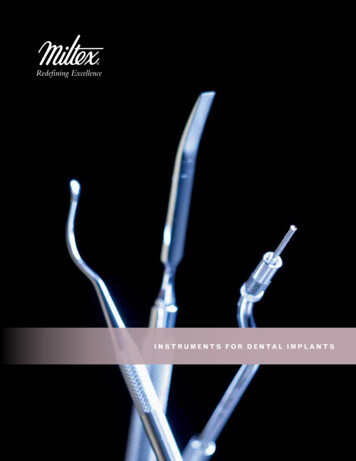
Transcription
Surgical Care Improvement Project (SCIP) began as a national quality partnership committed toimproving patient safety by driving down postoperative complications by 25% by 2010. By implementing SCIPquality measures, it is estimated that hospitals can prevent an estimated 13,000 patient deaths and 271,000surgical complications each year (AORN J 86 (July 2007)94-101). SCIP is a national priority of the Institute ofHealthcare Improvement (IHI) 10,000 lives Campaign, a focus for The Joint Commission and The Centers forMedicare and Medicaid Services (CMS). SCIP continues to be an area with an opportunity for improvement atUHS facilities. Improvement in the quality of perioperative care delivery can be evidenced by achieving andsustaining 100% in all SCIP measures.The SCIP measures include:A. Antibiotic Prophylaxis:1.) Antibiotic received within one hour prior to surgical incision, SCIP INF 12.) Appropriate Antibiotic selection for surgical patients, SCIP INF-2 and3.) the Prophylactic Antibiotics discontinued within 24 hours after surgery time, 48 hours for CABG andother cardiac surgery. SCIP INF-3B. Cardiac surgery patients with controlled 6am postoperative serum glucose ( 200 mg/dL) on post-op day 1and 2.C. Surgery patients with appropriate hair removal. No hair removal, or removal with clippers or depilatory isconsidered appropriate, with few exceptions.D. Colorectal surgery patients with immediate normothermia ( 96.8 F) within the first hour after leavingoperating room.E. Surgery patients on Beta Blocker Therapy prior to admission who received a Beta Blocker during theperioperative period (prior to leaving the post operative acute care unit (PACU) or within six hours for thosenot recovered in the PACU).F. Venous Thromboembolism (VTE) Prophylaxis :1.) Surgery patients with recommended VTE prophylaxis ordered,2.) Surgery patients who receive appropriate VTE prophylaxis within 24 hours prior to surgery to 24hours after surgery.Type of SurgeryBeta Blocker RecommendationFor Patients without a documented contraindication, who take a beta-blocker prior to surgery, a beta blocker should be usedperioperatively to reduce the incidence of post-operative atrial fibrillation.Common Beta Blockers Bisoprolol metopolol tartrate propranololFor patients without contraindications who are undergoing noncardiac surgery and are currently on beta-blocker therapy, abeta-blocker should be used during the perioperative periodFor patients who are undergoing non-cardiac procedures,and NOT on a beta blocker prior to surgery, the evidence for theperioperative initiation of a beta-blocker for the prevention of perioperative outcomes is conflicting.Zynx References: Yup, sk., Tait, G., Karkaoit, K., Wijeysundera, D., McCluskey, S. Beattie, W.S., The Safety of perioperative esmolol:a systematic review and meta-analysis of randomized controlled trials. Anesth Analg. 2011;112:267-81; Bangalore S, Wetterslev J,Pranesh S, Sawhney S, Gluud C, Messerli FH. Perioperative beta blockers in patients having non-cardiac surgery: a meta-analysis.Lancet. 2008;372:1962-76. Beattie WS, Wijeysundera DN, Karkouti K, McCluskey S, Tait G. Does tight heart rate control improve betablocker efficacy? An updated analysis of the noncardiac surgical randomized trials. Anesth Analg. 2008;106:1039-48, table of contents.
Surgical Care Improvement Project (SCIP) ContinuedType of SurgeryAntimicrobial RecommendationCABG, other Cardiac orSingle Agents: CeFAZolin 1-2 gm IV or CefurOXime or Vancomycin.VascularIf ß-Lactam Allergy: Clindamycin 600-900 mg IV or Vancomycin 1 g IV.If known history of MRSA: Vancomycin 1 g IV or ClindamycinColonSingle Agents: CefOXitin 1-2 g IV. Cefotetan, Ampicillin sulbactam or ertapenem; Combinationregimen MetroNIDAZOLE 500 mg IV and CeFAZolin or cefuroximeIf ß-Lactam Allergy: Clindamycin and aminoglycoside or Quinolone or aztreonam or Aminoglycosideand MetroNIDAZole or Quinolone and MetrNIDAZoleGeneral Surgery (hepatectomySingle Agent: CeFAZolin 1g IVgastrectomy)Other General SurgicalProceduresIf ß-Lactam Allergy: MetroNIDAZole 500 mg IV and Ciprofloxacin 400 mg IV(e.g. hernia repair, breast)Gynecological Procedures(e.g. hysterectomy -is includedin SCIP)Single Agent: CeFAZolin 1-2 g IV. If ß-Lactam Allergy: Clindamycin 600-900 mg IV or Vancomycin1 g IV. If known history of MRSA: Vancomycin 1 g IVSingle Agent: ceFAZolin 1 g IV, Cefoxitin 1-2 g IV, cefotetan or cefurOXime;If c-section and group B Strep prophylaxis: ceFAZolin, ampicillin or penicillinIf ß-Lactam Allergy: MetroNIDAZole 500 mg IV and Aminoglycoside,MetroNIDAZole and clindamycin or Quinolone or Clindamycin and aztreonam** if Hysterectomy with colonSingle Agent: Cefoxitin 1-2 g IV, ceFAZolin, cefotetan or cefurOXime or ampicillin/sulbactam orsurgeryertapenemIf ß-Lactam Allergy: MetroNIDAZole 500 mg IV and Aminoglycoside, Clindamycin andAminoglycoside or Clindamycin and aztreonam or MetroNIDAZole and QuinoloneNeurosurgeryOrthopedic: Hip/KneeArthroplastySingle Agent: CeFAZolin 1-2 g IV. If ß-Lactam Allergy: Clindamycin 600-900 mg IV or Vancomycin 1g IV. If known history of MRSA: Vancomycin 1 g IVSingle Agent: CeFAZolin 1-2 g IV. Or CefurOXime or vancomycinIf ß-Lactam Allergy: Clindamyin 600-900 mg IV or Vancomycin 1 g IV.If known history of MRSA: Vancomycin 1 g IVAmerican Academy of Orthopaedic Surgeons, American Association of Critical Care Nurses, American Association of Nurse Anesthetists, American College of Surgeons,American College of Osteopathic Surgeons, American Geriatrics Society, American Society of Anesthesiologists, American Society of Colon and Rectal Surgeons, AmericanSociety of Health-System Pharmacists, American Society of PeriAnesthesia Nurses, Ascension Health, Association of periOperative Registered Nurses, Association forProfessionals in Infection Control and Epidemiology, Infectious Diseases Society of America, Medical Letter, Premier, Society for Healthcare Epidemiology of America,Society of Thoracic Surgeons, Surgical Infection Society. Antimicrobial prophylaxis for surgery: an advisory statement from the National Surgical Infection Prevention Project.Clin Infect Dis 2004 Jun 15;38(12):1706-15. [90 references] PubMedEdwards FH, Engelman RM, Houck P, Shahian DM, Bridges CR, Society of Thoracic Surgeons. TheSociety of Thoracic Surgeons Practice Guideline Series: Antibiotic Prophylaxis in Cardiac Surgery, Part I: Duration. Ann Thorac Surg 2006 Jan;81(1):397-404. PubMed
Surgical Care Improvement Project (SCIP) ContinuedSurgery & Level of RiskRecommended VTE ProphylaxisGeneral surgery, moderate – high risk (Open surgical Any of the following: Low-dose Unfractionated Heparin (LDUH)procedure 30 minutes requiring in hospital stay 245000units bid or tid Low Molecular Weight Heparin (LMWH) Factorhours post-op)Xa Inhibitor LDUH or LMWH combined with Intermittent PneumaticCompression (IPC) or Graduated Compression Stockings (GCS).General surgery with high risk for bleeding (based onAny of the following: GCS IPCphysician documentation of bleeding risk) Open surgicalOf note is the recommendation that IPCs be worn 23 hours a day to beprocedure 30 minutes requiring hospital stay 24 hourseffectivepost-opGynecologic surgery - Open surgical procedure 30Any of the following: LDUH 5000 units bid or tid LMWH IPC LDUHminutes and requiring hospital stay 24 hours post-op Factor Xa Inhibitor or LMWH combined with IPC or GCSUrologic surgery - Open surgical procedure 30 minutesAny of the following: LDUH 5000 units bid or tid LMWH IPCrequiring hospital stay 24 hours post-op Factor Xa Inhibitor LDUH or LMWH combined with IPC or GCSElective total hip replacement - Open surgicalAny of the following started within 24 hours of surgery: LMWH Factorprocedure 30 minutes requiring hospital stay 24 hoursXa Inhibitor Oral Factor Xa Inhibitor Adjusted-dose Warfarin (INRpost-optarget 2.5, range 2.0-3.0)Elective total knee replacement - Open surgicalAny of the following started within 24 hours of surgery: LMWH Factorprocedure 30 minutes requiring hospital stay 24 hoursXa Inhibitor Oral Factor Xa Inhibitor Adjusted-dose Warfarin (INRpost-optarget 2.5, range 2.0-3.0)Hip fracture surgery - Open surgical procedure 30Any of the following: LMWH LDUH Factor Xa Inhibitor Adjusted-minutes requiring hospital stay 24 hours post-opHip fracture surgery or elective total hip replacementdose Warfarin (INR target 2.5, range 2.0-3.0)with high risk for bleeding (based on physiciandocumentation of bleeding risk) Open surgical procedure 30 minutes requiring in hospital stay 24 hrs post-op GCSAny of the following: GCS IPCOf note is the recommendation that IPCs be worn 23 hours a day to beeffectiveElective spinal surgery (With additional risk factors suchAny of the following:as advanced age, known malignancy, presence of a LDUH IPC LMWH GCS IPC combined with GCSneurologic deficit, previous VTE, or an anterior surgical LDUH or LMWH combined with IPC or GCSapproach) (Open surgical procedure 30 minutesOf note is the recommendation that IPCs be worn 23 hours a day to berequiring hospital stay 24 hours post-op)effectiveIntracranial neurosurgery (Open surgical procedure Any of the following:30 minutes requiring hospital stay 24 hours post-op) LMWH IPC with or without GCS LDUH LDUH or LMWH combinedwith IPC or GCSPatients who receive neuraxial anesthesia or have physician documented bleeding risk may pass the performance measure ifappropriate pharmacologic or mechanical prophylaxis is ordered. http://ahrq.hhs.gov/qual/vtguide last accessed 01/03/12 ACCP Guidelines.Preventing VTE in Hospitalized Patients: Progress and Remaining Challenges – Geerts (2011) . www.ahrq.gov/clinic/ptsafety CMS SCIP 4.0
Role Owner Role DescriptionSo What is Your Role? SCIP Adapted from the Stanford Best Practices ModelROLE OWNER oactive ChartManager/Preadmission Nurse:prior to day ofsurgeryPre-Op RN/ HoldingAreaOR RNPACU RN:Unit RN: Take pre-op antibiotics with patient from pre-op area Start/administer ALL pre-op antibiotics in OR prior to surgical incision. Document antibiotic name and administration time on Anesthesia Record Document Beta Blocker assessment and time of last dose within 24 hours Actively participate in “Time-out” Verify Beta Blocker is given when appropriate before the patient transfers from the PACU to theunit or within six hours of surgery end time when patient is recovered in a unit other than thePACU. Order appropriate antibiotics and discontinue within 24 hours after surgery, except cardiacsurgeries (can be found above, in the CDC antibiotic stewardship guidelines, on the pre-printedEvidenced-based order sets, on the zynx tools, on the ACC and ATS and national SCIP Partnership,IHI and AHRQ sites & on the Sharepoint ). Order Venous Thromboembolism (VTE) prophylaxis per guidelines (can be found on pre-printedEvidence-based order sets, zynx tools, ACCP VTE 7th Congress, ACS guidelines, IHI, AHRQ, & above,on this document) If no antibiotic is indicated for surgery, please document in patient’s chart. If no chemical VTE prophylaxis order, please document contraindication, such as risk for bleeding. Review all surgery patients medications prior to surgery; preferably from preadmissioninformation when surgery is scheduled and surgeons orders are received, including prophylacticantibiotic and VTE prophylaxis. If prophylactic antibiotic and/or VTE prophylaxis orders are not appropriate, contact thesurgeon. If prophylactic antibiotic is unit dose dispensed, release only the appropriate number ofunits/doses for the patient/case verify surgery end time with PACU Nurse– create a hard stop. Check for antibiotic and VTE orders. Notify surgeon’s office if orders are missing or not complete. Collect patient list of prescription, OTC and herbal medications Send patient’s medications list to pharmacy for review along with surgeon’s orders If antibiotic section in pre-op order form is not complete, call Surgeon. Obtain ordered pre-op antibiotic from Pyxis/pharmacy. Place on patient’s chart with patient’slabel/hang the antibiotic on the pole prior to patient moving to the OR. Check if VTE prophylaxis is ordered (SCDs and/or Heparin). If no VTE prophylaxis is ordered, call MD. Actively participate in “Time Out”. Include review of prophylactic antibiotic start before incision Verify surgery end time, antibiotic, VTE and beta blocker orders with pharmacist. Administer antibiotic and VTE prophylaxis and beta blocker as needed. Document in PACU report form and communicate to unit RN name of antibiotic and verify time ofadministration, VTE prophylaxis and beta blocker, if applicable, prior to patient leaving PACU When getting report from PACU nurse, verify completion of documentation of antibiotic, VTE andbeta blocker. Verify time of last antibiotic dose in PACU report form. Look in OR case record for the surgery end time. Ensure entire course of post-op prophylactic antibiotics are administered within 24 hours fromSurgery end time, 48 hours for CABG.
Community Acquired Pneumonia (CAP) is defined most often as pneumonia not acquired in a hospital orlong-term care facility. Despite the availability of potent new antimicrobials and effective vaccines, an estimated 5.6million cases of CAP occur annually in the United States. The estimated total annual cost of health care for CAP in theUnited States is 8.4 billion. According to the Centers for Disease Control and Prevention 2001 data, influenza andpneumonia were the seventh leading cause of death in the United States.Evidence based practices supported by the American Academy of Family Practice, the Infectious Disease Society ofAmerica, the American Thoracic Society and others include: use of chest radiography when CAP is suspected, use of the Pneumonia Severity Index to assist in decisions regarding hospitalization or outpatient treatment, initial treatment with empiric and macrolides or doxycyline (Vibracycin) in most patients and use of respiratory fluoroquinolones when patients have failed first-line regimens, have significant comorbidities,have had recent antibiotic therapy, are allergic to alternative agents, or have a documented infection withhighly drug-resistant pneumococci.According to Dr. Paula Peyrani, pneumonia represents significant morbidity and mortality risks to patients, increasedhealthcare costs and potential risk to healthcare workers. In the APIC Guidelines, she defines components of aneffective infection control program necessary to improve medical care and patient outcomes. The components, nowincluded in public reporting, are: identifying the most likely etiology of the pneumonia, targeting and streamlining antimicrobial therapy, developing and implementing strategies to prevent development of pneumonia and ensuring the safety of other patients and healthcare workers through immunization and environment controls.Collecting blood cultures prior to antibiotic administration offers the best hope of identifying the organism that causedsepsis in an individual patient. Failure to check blood cultures prior to antibiotic infusion will, perhaps affect the growthof any blood borne bacteria and prevent a culture from becoming positive later.Studies show that the best way to consistently achieve key recommendations for practice and cost-saving approaches tothe treatment of patients with CAP is by using a clinical pathway. Clinical pathways are a method of facilitatingmultidisciplinary patient care by moving processes of care sequentially through various stages, within specified timeframes, toward a desired outcome. Pathways should be specific to each institution and patient, and encourage the useof the most active, cost-effective agents to produce rapid, positive clinical outcomes. Evidence of providing care that isconsistent with the evidence based guidelines for patients with CAP can be shown by achieving 100% on the followingmeasures:1.Oxygen assessment2.Blood culture drawn before the first dose of antibiotics is administered3.First dose of antibiotics within six hours of arrival4. Appropriate antibiotic selection5. Influenza and pneumonia vaccination, and6. Smoking cessation counselingOutcome measure: 30 day mortality rateAndrews J, Nadjm B, Gant V, Shetty N. Community-acquired pneumonia. Curr Opin Pulm Med. 2003;9:175–80.Niederman MS. Community-acquired pneumonia: management controversies, part 1; practical recommendations from the latest guidelines. J Respir Dis. 2002;23:10–7.Mandell LA, Bartlett JG, Dowell SF, File TM Jr, Musher DM, Whitney C. Infectious Diseases Society of America. Update of practice guidelines for the management of community-acquired pneumonia inimmunocompetent adults. Clin Infect Dis. 2003;37:1405–33.Campbell SG, Marrie TJ, Anstey R, Dickinson G, Ackroyd-Stolarz S. The contribution of blood cultures to the clinical management of adult patients admitted to the hospital with community-acquiredpneumonia: a prospective observational study. Chest. 2003;123:1142–50Fine MJ, Auble TE, Yealy DM, Hanusa BH, Weissfeld LA, Singer DE, et al. A prediction rule to identify low-risk patients with community-acquired pneumonia. N Engl J Med. 1997;336:243–50.Fine MJ, Hough LJ, Medsger AR, Li YH, Ricci EM, Singer DE, et al. The hospital admission decision for patients with community-acquired pneumonia. Results from the Pneumonia Patient OutcomesResearch Team cohort study. Arch Intern Med. 1997;157:36–44.Fine MJ, Pratt HM, Obrosky DS, Lave JR, McIntosh LJ, Singer DE, et al. Relation between length of hospital stay and costs of care for patients with community-acquired pneumonia. Am J Med.2000;109:378–85.Coffey RJ, Richards JS, Remmert CS, LeRoy SS, Schoville RR, Baldwin PJ. An introduction to critical paths. Qual Manag Health Care. 1992;1:45–54
The Pneumonia severity Index can serve as a general guideline for management. However, clinical judgement should always supersede a prognosticscore.Pneumonia Severity IndexPatient Characteristics PointsDemographicsMaleAge(years)FemaleAge (years) 10Nursing home residentComorbid illnessNeoplastic disease 10Liver disease 20Congestive heart failure 10 30Cerebrovascular disease 10Renal diseasePhysical examination findings 10Altered mental status 20Respiratory rate 30 breaths per minute 20Systolic blood pressure 90 mm Hg 20Temperature 35 C (95 F) or 40 C (104 F) 15Pulse rate 125 beats per minuteLaboratory and radiographic findingsArterial pH 7.35 10 30Blood urea nitrogen 64 mg per dL(22.85 mmol per L) 20Sodium 130 mEq per L (130 mmol per L) 20Glucose 250 mg per dL (13.87 mmol per L) 10Hematocrit 30 percent 10Partial pressure of arterial oxygen 60 mm Hg oroxygen percent saturation 90 percent 10Pleural effusion 10Total points:Point totalRiskRiskClassIMortality%(# of Patients)0.1 (####)RecommendedSite of careOutpatientNo predictorsLow 7071 to 90LowII0.6 (####)OutpatientLowIII2.8 (####)Inpatient91 to 130Moderate IV8.2 (####)Inpatient 130High V29.2 (####)Inpatient(briefly)*The Pneumonia severity Index can serve as a general guideline for management. However, clinical judgement should always supersede a prognosticscore.
The Centers for Medicare & Medicaid Services (2011) & The Joint Commission (2011) specify the following antimicrobials for adultpatients hospitalized with CAP: Reference ZynxEvidence last minor update Dec 11, 2011; last major update Sept 12, 2010Regimens by Patient TypeInpatient, Non-ICUIV or oral macrolide IV or intramuscular beta-lactamOrIV or intramuscular beta-lactam IV or oral doxycyclineOrIV tigecycline monotherapyOrIV or oral antipneumococcal quinolone monotherapySpecified Antimicrobials ICU PatientsIV macrolide (IV beta-lactam or IVantipneumococcal/antipseudomonal beta-lactam)OrIV antipseudomonal quinolone (IV beta-lactam or IVantipneumococcal/antipseudomonal beta-lactam)OrIV an
quality measures, it is estimated that hospitals can prevent an estimated 13,000 patient deaths and 271,000 surgical complications each year (AORN J 86 (July 2007)94-101). SCIP is a national priority of the Institute of . Prev
